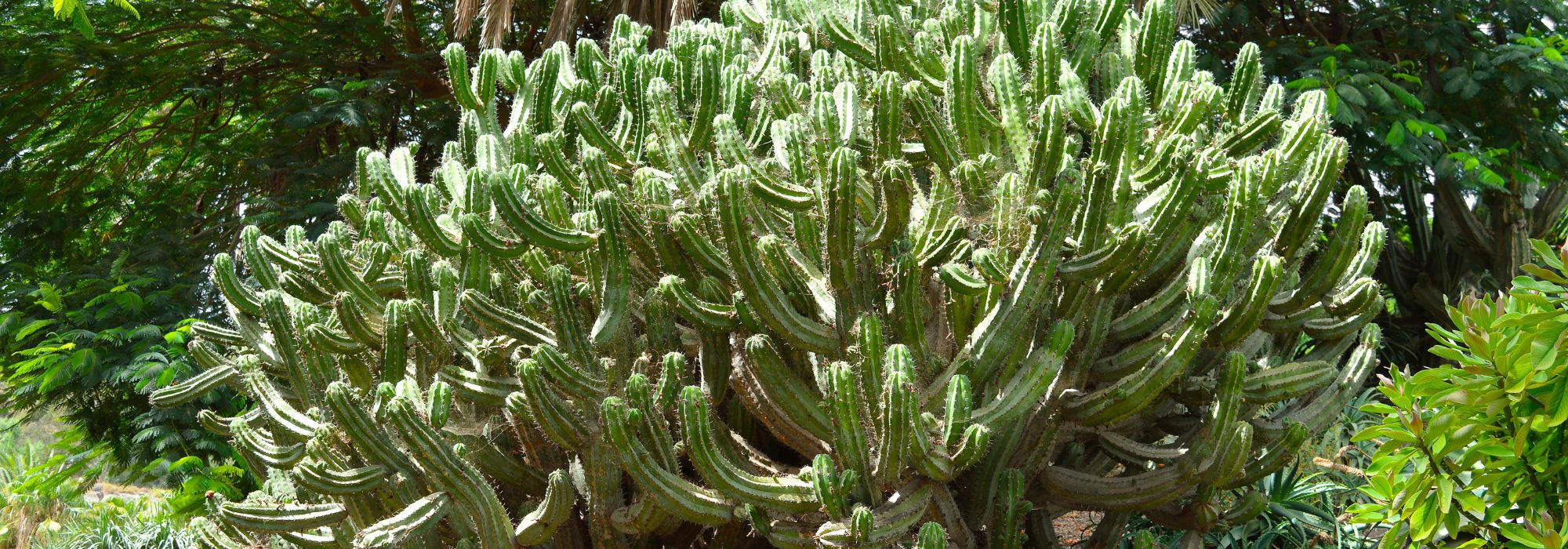
Polaskia chichipe: growing and caring for
Contents
Polaskia in a nutshell
- Polaskia is a columnar cactus native to Mexico, very decorative and easy to cultivate.
- It enjoys bright light, well-drained soil, and infrequent watering.
- Polaskia chende and Polaskia chichipe are the most common species in cultivation.
- It propagates easily by cuttings and is particularly sensitive to excess moisture.
- Perfect for indoors, it adds a graphic touch in a raw pot or a dry terrarium.
A word from our expert
Originating from the arid regions of Mexico, Polaskia is a genus of columnar cactus belonging to the family of Cactaceae. Appreciated for its upright habit and sculptural appearance, it is represented notably by two emblematic species: Polaskia chichipe and Polaskia chende. These cacti are distinguished by their adaptability, their graphic silhouette, and their discreet yet charming flowering, often yellow or pink depending on the varieties.
Cultivated in a pot, Polaskia thrives in bright light, ideally in a south or west-facing position, and requires a very well-draining mineral substrate. It enjoys warm temperatures and can tolerate brief periods of dry coolness. Watering remains moderate during the growing season, spaced out in autumn, and almost non-existent in winter.
Very easy to care for, this cactus mainly propagates by cuttings. However, it remains susceptible to some pests like mealybugs, and to excess moisture which can cause rot.
Finally, Polaskia fits perfectly into bright interiors with contemporary, bohemian, or industrial styles. It can be showcased in a terracotta pot, in concrete, or in a well-ventilated dry terrarium. With its vertical silhouette, it is perfect for structuring a plant shelf or creating a chic desert atmosphere in your living room.
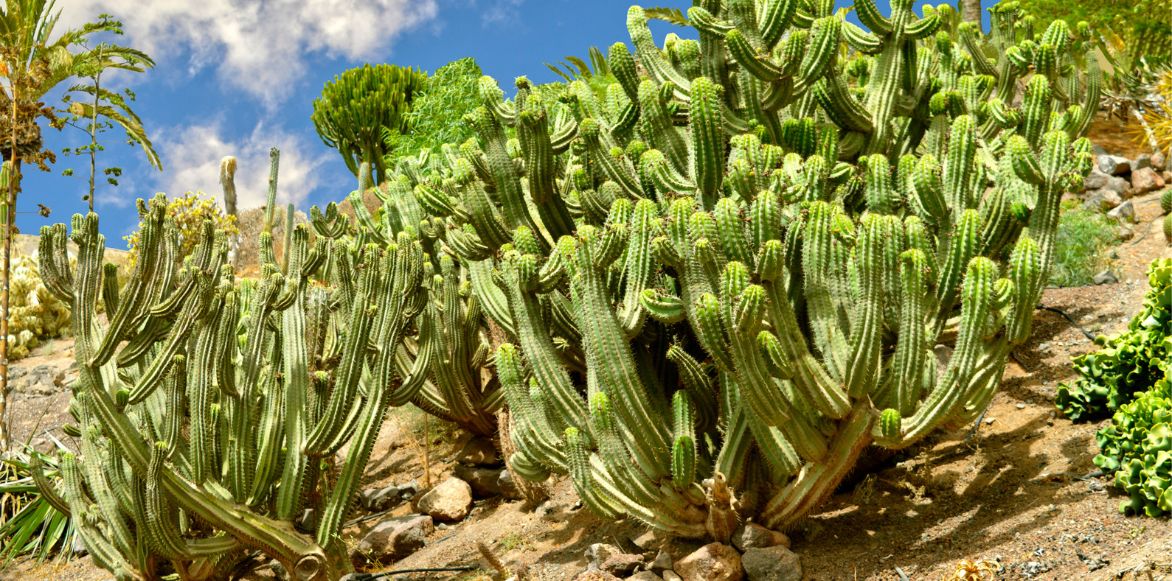
In the wild, Polaskia chichipe becomes an imposing cactus.
Botany and description
Botanical data
- Latin name Polaskia spp.
- Family Cactaceae
- Common name Mexican columnar cactus
- Flowering June to August
- Height 1.50 m
- Sun exposure sun or bright light
- Soil type very well-draining sandy potting mix
- Hardiness 10°C
The Polaskia belongs to the large family of Cactaceae, succulent plants adapted to arid environments. This genus is named after Charles Polaski, an American botanist who contributed to the study of cacti. Although not well known by common names in French, it is sometimes simply referred to as “Mexican columnar cactus”, in reference to its elongated shape and geographical origin.
In its natural habitat, Polaskia primarily grows in the dry and semi-arid regions of Mexico, particularly in rocky areas where it can benefit from good drainage and strong sunlight. It adapts perfectly to these extreme conditions thanks to its ability to store water in its fleshy tissues and its thorns that limit moisture loss.
It is precisely this robustness and its graphic appearance that make it an increasingly popular houseplant. The Polaskia requires little maintenance, tolerates forgetfulness in watering, and adds a touch of exoticism with its tall green columns, sometimes crowned with small flowers.
Among the most commonly cultivated species are the Polaskia chende, valued for its relatively fast growth and very decorative silhouette, as well as the Polaskia chichipe, which is appealing for its compactness and colourful flowers.

Flowering and thorns of a Polaskia chende.
The Polaskia is distinguished by a very vertical columnar habit, almost sculptural, evoking the desert landscapes where it naturally thrives. It often forms a single trunk in its early years. However, over time, this can branch from the base or higher up the stem, giving the plant a miniature tree appearance, particularly in the case of Polaskia chende. This height development, reaching several metres in its natural habitat, is significantly more modest in a pot, where it maintains an elongated and orderly silhouette.
Its root system is fasciculate and shallow, well adapted to rocky and poor soils. This type of root allows the plant to quickly capture moisture at the surface of the soil, which is essential in arid areas where rainfall is rare but sometimes intense. In cultivation, this means that the plant is sensitive to excess stagnant water, hence the importance of a very well-draining substrate.
The trunk and branches, thick and ribbed, are covered with a green skin that ensures photosynthesis in the absence of true leaves. The ribs, well-defined, allow the plant to expand to store water after rain, then contract during dry periods, a typical mechanism of cacti. These ribs are punctuated by areoles, small wooly cushions from which the thorns emerge, and which also mark the points of growth and flowering.
Foliage, in the traditional sense, is absent, as is often the case with cacti. It is the stems themselves that fulfill this role, which limits transpiration and allows the plant to survive in extreme conditions. The thorns, more or less dense depending on the species, play a protective role against herbivores but also against excess sunlight.
Flowering is a spectacular moment despite its relative discretion. In the case of Polaskia chichipe, for example, small funnel-shaped flowers open along the areoles, often at the top of the stems, in shades ranging from yellow-green to pale pink. They generally bloom at night or early in the morning, suggesting pollination by nocturnal insects or bats.
After flowering, if pollination has occurred, fruits may form. These small fleshy fruits, often red or purple, are edible and sometimes sweet, although they remain rare in domestic cultivation. They contain numerous black seeds, dispersed in nature by animals that consume the fruit.
 Some details of the cactus Polaskia chichipe.
Some details of the cactus Polaskia chichipe.
The most well-known species
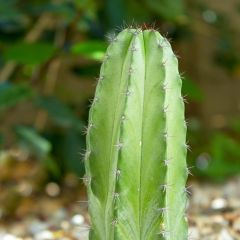
Polaskia chichipe - Cactus
- Période de floraison July to September
- Hauteur à maturité 1,50 m
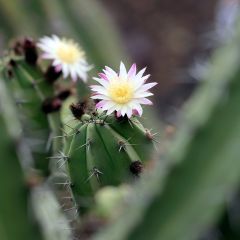
Polaskia chende - Cactus
- Hauteur à maturité 1,50 m
Planting Polaskia
When to plant your Polaskia?
The best time to plant or repot a Polaskia is in spring, when the plant comes out of its winter dormancy and enters its active growth period. This mild season promotes good rooting without stress for the plant.
What substrate to use for growing a Polaskia?
In terms of substrate, Polaskia needs a very draining mix. Ideally, start with a base of cactus compost, which can be enriched with a third of coarse sand or perlite, and possibly a bit of fine gravel or pumice. The goal is to replicate a dry, stony soil where water never stagnates. Good drainage is key to avoiding root rot, the main enemy of cacti.
What exposure should you give your columnar cactus?
Place it in a very bright spot: a conservatory, a well-exposed balcony, or a south-facing window are perfect. Polaskia loves full sun, but if the plant was previously in the shade, it should be gradually acclimatised to avoid sunburn on its stems.
In terms of temperature, it thrives between 20 and 30 °C during the warm season, but it tolerates cooler temperatures as long as they remain above 5 °C. It does not like excessive ambient humidity, so avoid overly humid rooms like the bathroom.
How to plant a Polaskia?
Choose a pot that is slightly wider than the root ball, but not too deep, as the roots do not go very far down. The material is also important: terracotta pots are ideal because they allow the roots to breathe and help to expel moisture. It is essential that the pot has a drainage hole.
Here’s how to plant a Polaskia step by step:
-
Start by placing a layer of gravel or clay balls at the bottom of the pot to promote drainage.
-
Then fill the pot halfway with the prepared substrate.
-
Gently remove the plant from its original pot, being careful not to damage the roots. If they are very tight, you can gently untangle them with your fingers.
-
Place the root ball in the centre of the pot, adjusting the height so that the collar (the base of the stem) is just level with the top edge of the pot.
-
Fill in with substrate all around, pressing down lightly, without burying the base of the stem.
-
Do not water immediately: wait 5 to 7 days to allow any wounds on the roots to heal, then water moderately.
Repotting should be done every two to three years, or when the plant becomes too cramped in its pot. This is also an opportunity to renew the substrate, which loses quality over time. Take the chance to check the condition of the roots, and cut away any damaged or rotten parts with a clean tool.
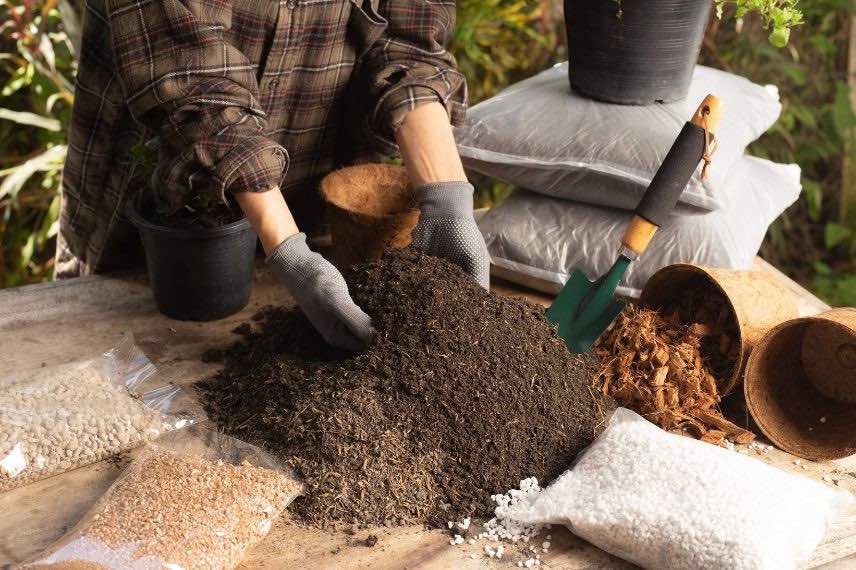
The substrate should be as light as possible for cacti.
How to care for your Polaskia?
Watering
The watering of Polaskia follows the rhythm of the seasons. During the growth period, from spring to the end of summer, it needs water, but always in moderation. Wait for the substrate to be well dry on the surface before watering again. Generally, watering every 10 to 15 days is sufficient, adjusting according to heat and exposure. Water should drain well from the bottom of the pot, and always empty the saucer afterwards. In autumn, gradually space out the waterings, and in winter, almost stop altogether: a small glass of water per month at most, just to prevent the roots from completely drying out.
Fertilisation
In terms of fertilisation, Polaskia is not very demanding, but you can use a liquid fertiliser specially formulated for cacti, low in nitrogen and high in potassium, once a month at most, diluted in the watering water. Above all, no fertiliser in autumn or winter, when the plant is dormant.
Pruning
Pruning is generally not necessary. Polaskia maintains a naturally harmonious shape. That said, if a part of the cactus becomes too large, damaged, or poorly placed, you can cleanly cut it with well-disinfected pruning shears. You should then let the wound dry for a few days before resuming watering. The cuttings taken can also be replanted to obtain new plants, after a good drying in the open air for about a week.
Possible Precautions
Be vigilant regarding excess moisture, the real trap for this plant. A Polaskia that starts to soften or brown at the base is often a victim of rot. You must act quickly, cutting the healthy parts and propagating them if possible. Also be cautious with temperatures that are too low: below 5 °C, it can suffer, especially if the substrate is moist.
Caution: its thorns can be formidable, so always handle it with thick gloves or by wrapping it in folded newspaper. Ensure it is not too close to a frequently used passage to avoid injuries.
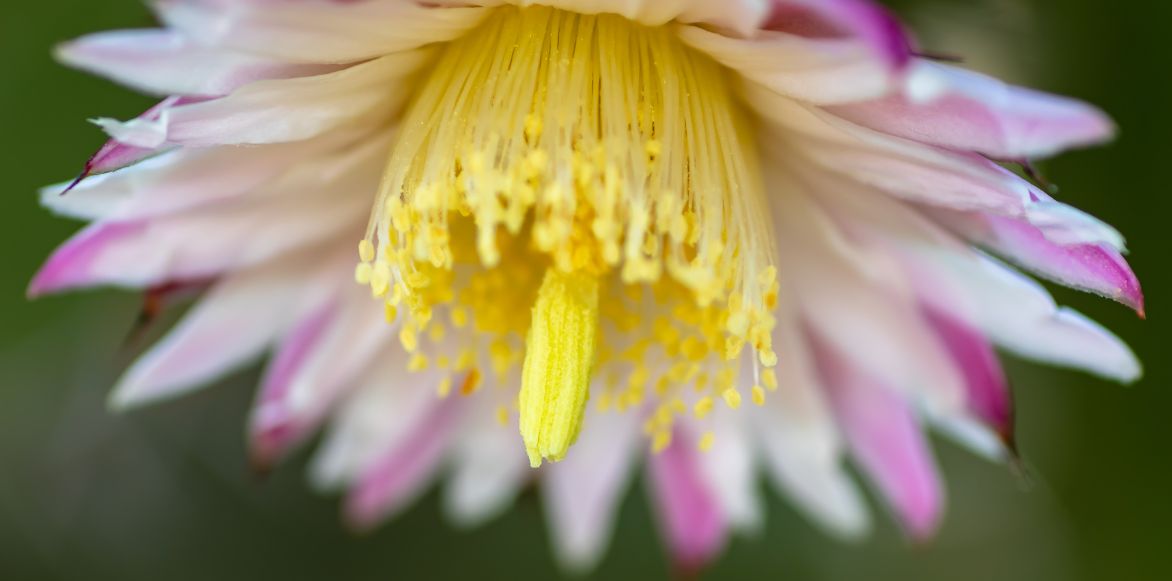
The astonishing flowering of a Polaskia chende
Potential diseases and pests of Polaskia
The most common pests are the scale insects, particularly mealybugs. They settle in the crevices between the midribs or at the base of the areoles, where they find a nice cozy shelter. You will recognise them by their white cottony appearance. They suck the sap, slow down growth, and can even cause deformities if they settle in for the long term. They can be removed manually with a cotton bud soaked in 70° alcohol, or a gentle insecticidal product suitable for cacti can be used if the infestation is too severe.
Another possible pest is the red spider mites, especially in summer or in dry indoor conditions. They are tiny and difficult to see with the naked eye, but they leave small discoloured spots on the stems, as if the plant has been dusted with powder. Good ambient humidity and regular showers (outside of the resting period) help to prevent them. In case of infestation, a treatment with neem oil or an acaricide may be necessary.
Regarding diseases, root rot is by far the number one threat. It is almost always linked to excess water or poorly drained substrate. Symptoms include a soft base, stems that sag or blacken. To remedy this, the plant must be repotted, cutting away all damaged parts, allowing it to dry for a few days, and then replanting in a well-dried and clean substrate. Sometimes, only a cutting can be saved.
Finally, be careful of direct and harsh exposure to sunlight after a period in the shade. Even though it loves full sun, an unacclimatised Polaskia can get sunburned, visible as brown or red spots on its stems. Therefore, it is essential to gradually reintroduce it to intense light.
How to propagate your columnar cactus?
How to propagate Polaskia?
Propagation by cuttings is the fastest and most reliable method. It works very well with species such as Polaskia chende or Polaskia chichipe that tend to produce offsets or segments that are easy to detach.
-
Choose a healthy stem, neither too young nor too old. Cut cleanly with a well-disinfected knife, preferably at an angle to prevent water from pooling.
-
Allow the cutting to dry in the shade for about a week. The goal is for the wound to form a callus to prevent any rot when planting.
-
Prepare a small pot with a very well-draining substrate (cactus mix, coarse sand, a bit of perlite).
-
Plant the cutting just barely buried, enough for it to stand upright. Do not water it right away.
-
Wait another 10 to 15 days before the first watering, then resume light and spaced watering, as you would for an adult plant.
The cutting will produce roots in a few weeks if conditions are good (heat, light, no excessive moisture). You can test for rooting by gently pulling on the stem: if it resists, the roots are in place!
How to sow Polaskia seeds?
Sowing is slower than propagation by cuttings.
-
Collect ripe seeds from the fruits (if the plant has flowered), or buy certified fresh seeds.
-
Prepare a seed tray or small pots with a very fine, well-drained, but light substrate (sieved potting soil + sand).
-
Sow the seeds on the surface, without burying them, but pressing them down lightly. Moisten everything with a spray bottle.
-
Cover with a transparent lid or plastic wrap to create a mini-greenhouse effect, and place in light, around 25 °C.
-
Ventilate daily to prevent mould, and keep the substrate slightly moist.
-
The first germinations may appear in 1 to 3 weeks. Once the small cacti are large enough to handle (about 2 cm), you can carefully transplant them.
How to harmoniously integrate Polaskia into your interior?
Polaskia thrives in bright environments, and with its sculptural look, it is perfect for clean or minimalist décors. It easily finds its place in a contemporary style, with sharp lines and muted colours — imagine it in a raw concrete or white ceramic pot, placed near a south-facing window. It adds a touch of greenery without being overbearing, while asserting its personality.
In a bohemian or chic ethnic interior: one can slip a polaskia into a handmade terracotta cache-pot, in rattan or even in hammered metal, to play with textures. It can also be paired with other cacti or succulents in a Mexican desert-inspired composition, with pebbles, sand, and a few pieces of driftwood for a “cabin in the sun” effect.
Polaskia is also at home in an industrial décor: zinc or aged steel pot, raw wood and metal shelves, workshop-style lights…
Regarding containers, a dry terrarium can be a very nice option, provided it is well-ventilated. It is essential that humidity does not stagnate, so classic closed terrariums are out. However, a large open jar, a cut bottle, or a glass planter can work very well. You can create a mini desert scene with sand, volcanic stones, a few coloured gravels, and other mini cacti or euphorbias. As Polaskia is a bit larger, it can serve as the centrepiece in this composition.
Last point: as it loves light, it is best to avoid hiding it in a dark corner or among tropical plants with dense foliage. It needs a bright and airy spot to thrive, while maintaining that decorative aspect that catches the eye.
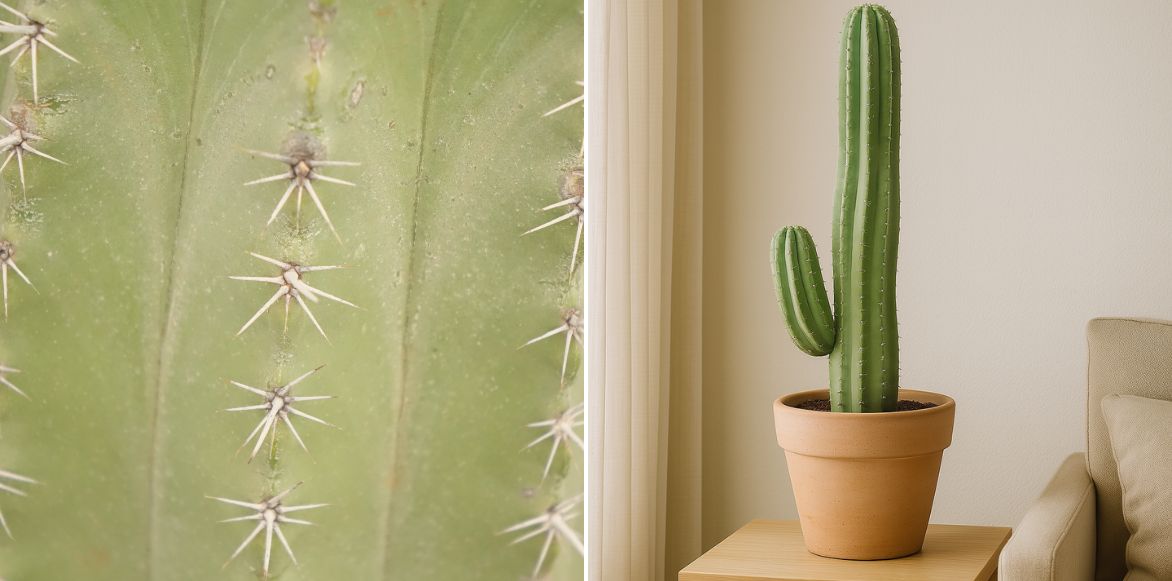
A Polaskia chichipe in pot (AI-generated image)
- Subscribe!
- Contents






























Comments